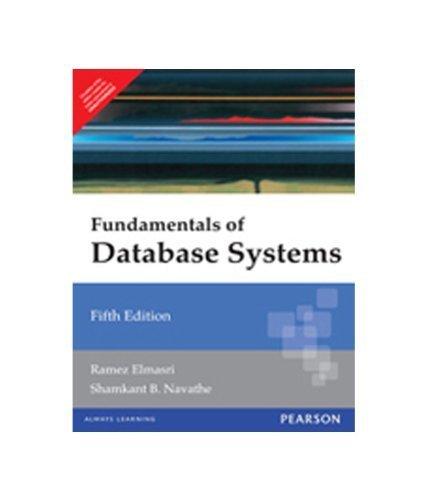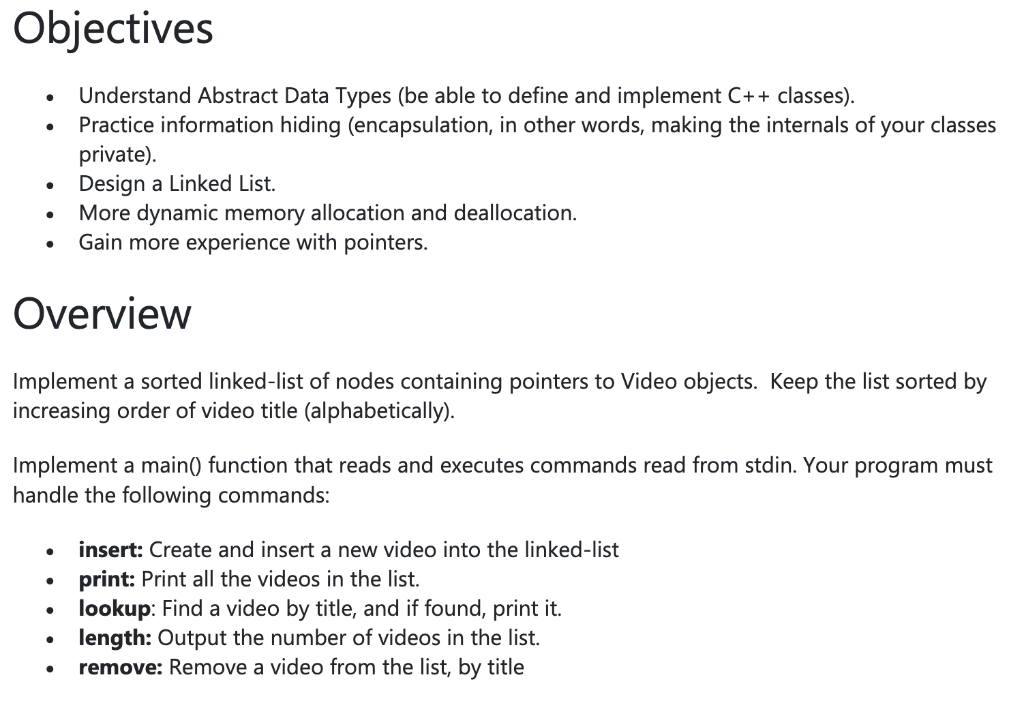
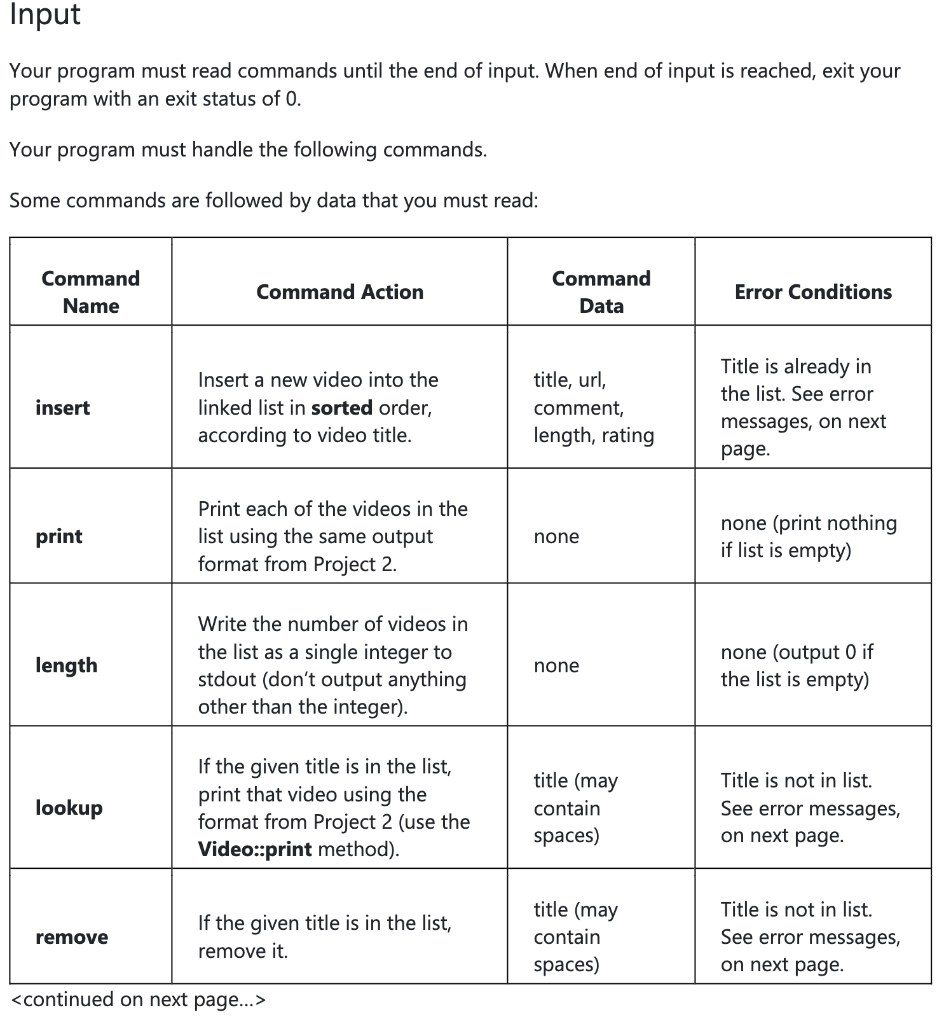
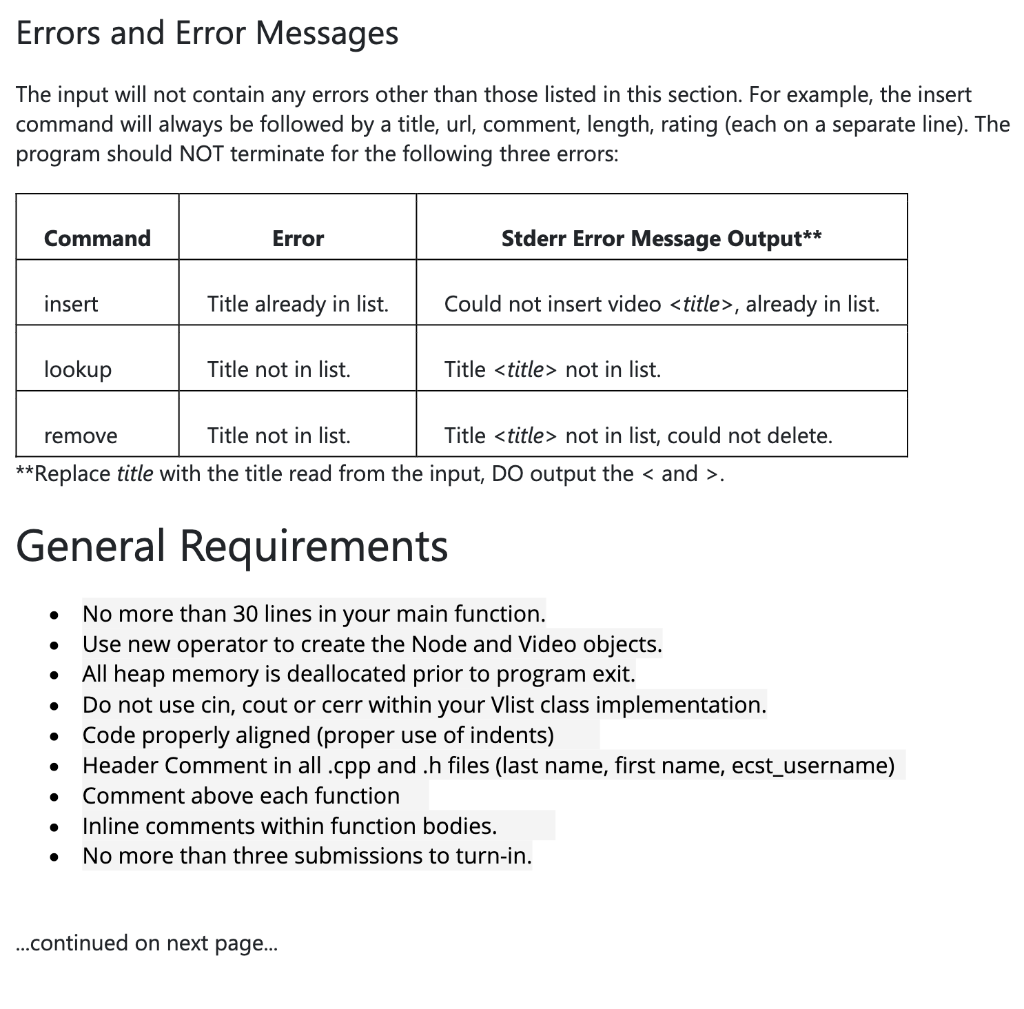
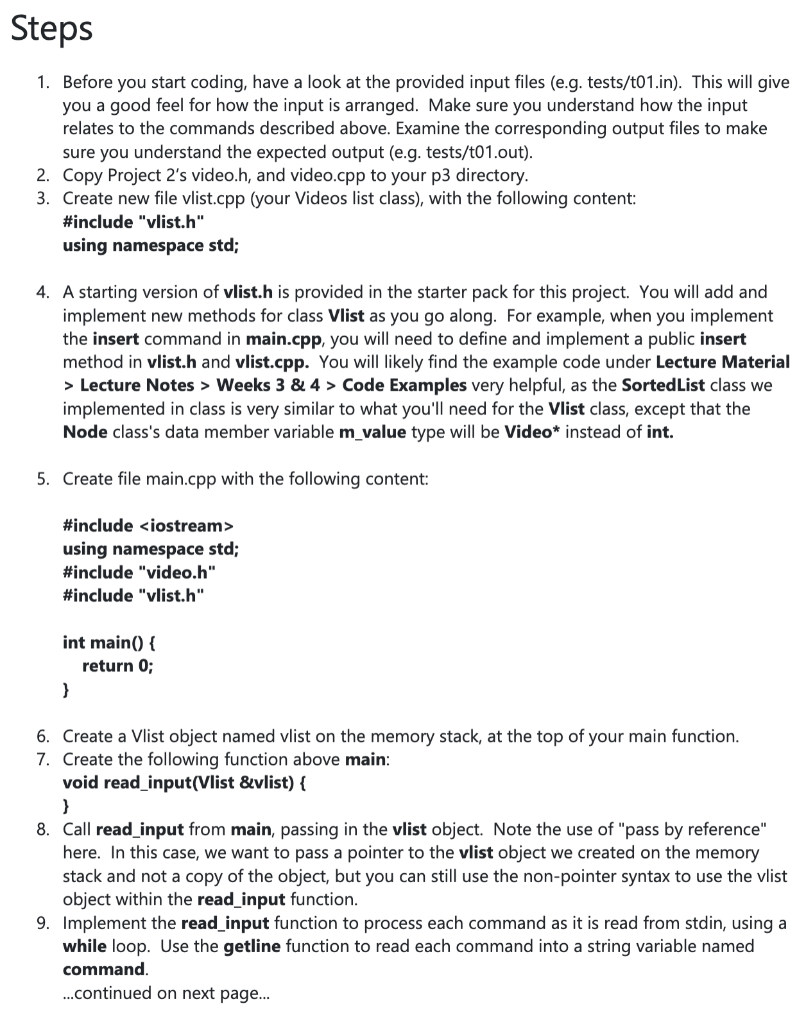
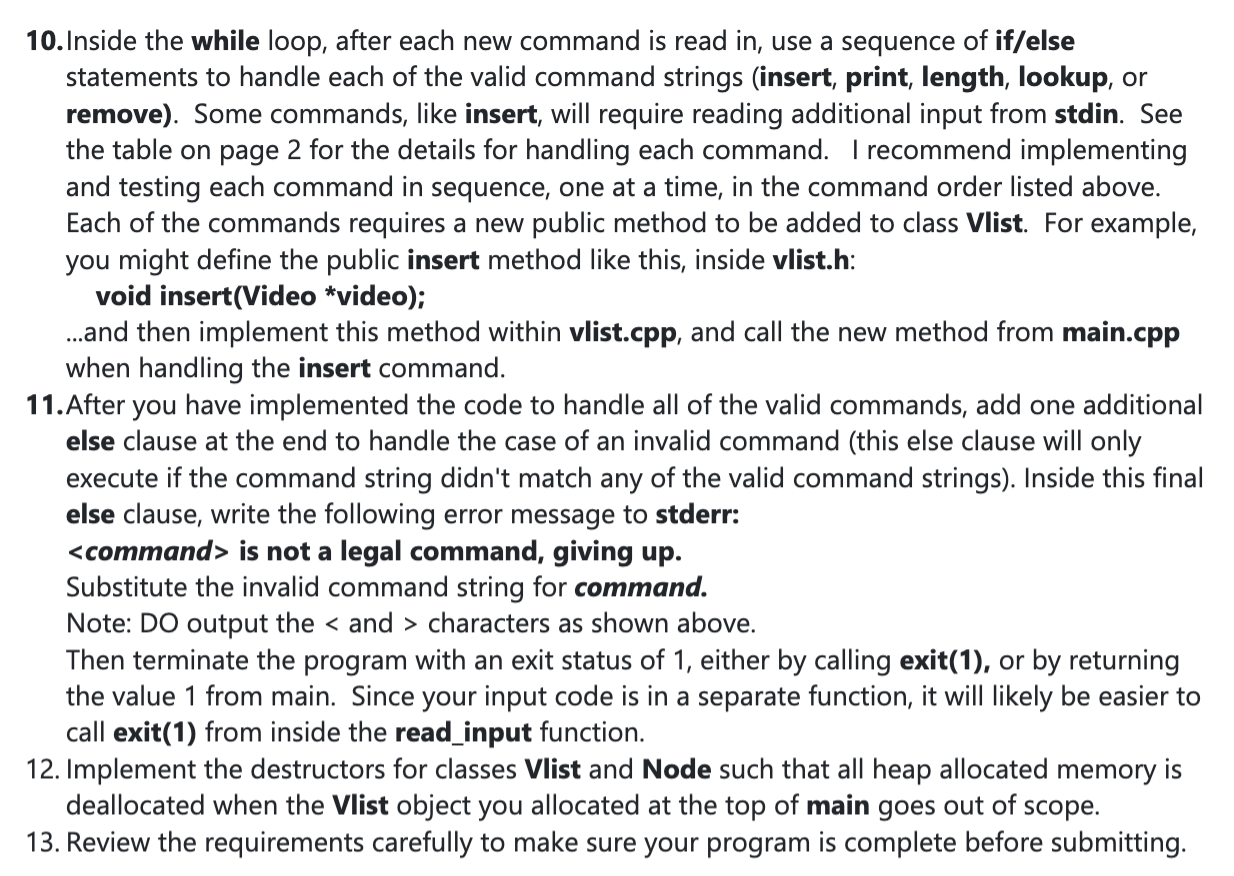
vlist.h
#ifndef VLIST_H
#define VLIST_H
#include "video.h"
class Vlist {
public:
void insert(string title, string url, string comment, double length, int rating);
void print();
void lookup(string title);
void remove(string title);
int length();
private:
class Node {
public:
Node(Video *video, Node *next) { m_video = video; m_next = next; }
Video *m_video;
Node *m_next;
};
Node *m_head;
};
#endif
video.cpp
#include
#include "video.h"
using namespace std;
Video::Video(string title, string url, string comment, double length, int rating)
{
m_title = title;
m_url = url;
m_comment = comment;
m_length = length;
m_rating = rating;
}
void Video::print()
{
cout
int index=0;
while(index {
cout
index++;
}
cout
}
bool Video::compareRatings(Video *otherVideo){
return m_rating m_rating;
}
bool Video::compareLengths(Video *otherVideo){
return m_length > otherVideo->m_length;
}
bool Video::compareTitles(Video *otherVideo){
return m_title > otherVideo->m_title;
}
bool Video::compare(Video* otherVideo, string sort){
if (sort == "title"){
return compareTitles(otherVideo);
}
else if (sort == "rating"){
return compareRatings(otherVideo);
}
else if (sort == "length"){
return compareLengths(otherVideo);
}
else{
return false;
}
}
video.h
#ifndef VIDEO_H
#define VIDEO_H
#include
using namespace std;
class Video
{
private:
string m_title;
string m_url;
string m_comment;
double m_length;
int m_rating;
public:
Video(string title, string url, string comment, double length, int rating);
void print(); //prototype
bool compare(Video* otherVideo, string sort);
bool compareTitles(Video *otherVideo);
bool compareRatings(Video *otherVideo);
bool compareLengths(Video *otherVideo);
};
#endif
Input:
length
Output:
0
- Understand Abstract Data Types (be able to define and implement C++ classes). - Practice information hiding (encapsulation, in other words, making the internals of your classes private). - Design a Linked List. - More dynamic memory allocation and deallocation. - Gain more experience with pointers. Overview Implement a sorted linked-list of nodes containing pointers to Video objects. Keep the list sorted by increasing order of video title (alphabetically). Implement a main() function that reads and executes commands read from stdin. Your program must handle the following commands: - insert: Create and insert a new video into the linked-list - print: Print all the videos in the list. - lookup: Find a video by title, and if found, print it. - length: Output the number of videos in the list. - remove: Remove a video from the list, by title Input Your program must read commands until the end of input. When end of input is reached, exit your program with an exit status of 0. Your program must handle the following commands. Some commands are followed hv data that vous must read. The input will not contain any errors other than those listed in this section. For example, the insert command will always be followed by a title, url, comment, length, rating (each on a separate line). The program should NOT terminate for the following three errors: **Replace title with the title read from the input, DO output the and . General Requirements - No more than 30 lines in your main function. - Use new operator to create the Node and Video objects. - All heap memory is deallocated prior to program exit. - Do not use cin, cout or cerr within your Vlist class implementation. - Code properly aligned (proper use of indents) - Header Comment in all .cpp and .h files (last name, first name, ecst_username) - Comment above each function - Inline comments within function bodies. - No more than three submissions to turn-in. Steps 1. Before you start coding, have a look at the provided input files (e.g. tests/t01.in). This will give you a good feel for how the input is arranged. Make sure you understand how the input relates to the commands described above. Examine the corresponding output files to make sure you understand the expected output (e.g. tests/t01.out). 2. Copy Project 2's video.h, and video.cpp to your p3 directory. 3. Create new file vlist.cpp (your Videos list class), with the following content: \#include "vlist.h" using namespace std; 4. A starting version of vlist.h is provided in the starter pack for this project. You will add and implement new methods for class Vlist as you go along. For example, when you implement the insert command in main.cpp, you will need to define and implement a public insert method in vlist.h and vlist.cpp. You will likely find the example code under Lecture Material > Lecture Notes > Weeks 3 \& 4 > Code Examples very helpful, as the SortedList class we implemented in class is very similar to what you'll need for the Vlist class, except that the Node class's data member variable mvalue type will be Video* instead of int. 5. Create file main.cpp with the following content: \#include using namespace std; \#include "video.h" \#include "vlist.h" int main() \{ return 0; 3 6. Create a Vlist object named vlist on the memory stack, at the top of your main function. 7. Create the following function above main: void read_input(Vlist \&evlist) \{ 3 8. Call read_input from main, passing in the vlist object. Note the use of "pass by reference" here. In this case, we want to pass a pointer to the vlist object we created on the memory stack and not a copy of the object, but you can still use the non-pointer syntax to use the vlist object within the read_input function. 9. Implement the read_input function to process each command as it is read from stdin, using a while loop. Use the getline function to read each command into a string variable named command. ...continued on next page... 10. Inside the while loop, after each new command is read in, use a sequence of if/else statements to handle each of the valid command strings (insert, print, length, lookup, or remove). Some commands, like insert, will require reading additional input from stdin. See the table on page 2 for the details for handling each command. I recommend implementing and testing each command in sequence, one at a time, in the command order listed above. Each of the commands requires a new public method to be added to class Vlist. For example, you might define the public insert method like this, inside vlist.h: void insert(Video *video); ...and then implement this method within vlist.cpp, and call the new method from main.cpp when handling the insert command. 11. After you have implemented the code to handle all of the valid commands, add one additional else clause at the end to handle the case of an invalid command (this else clause will only execute if the command string didn't match any of the valid command strings). Inside this final else clause, write the following error message to stderr: > is not a legal command, giving up. Substitute the invalid command string for command. Note: DO output the characters as shown above. Then terminate the program with an exit status of 1 , either by calling exit(1), or by returning the value 1 from main. Since your input code is in a separate function, it will likely be easier to











